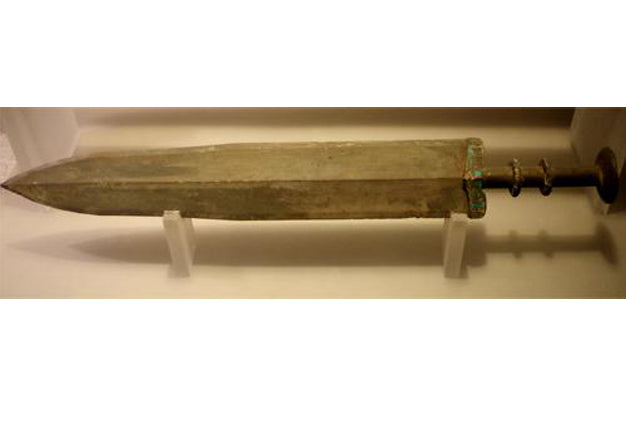
Bronze sword inlaid with turquoise

Bronze sword inlaid with turquoise, bronze, late Spring and Autumn Period, total length 41.3 cm. Unearthed in Gushi County, Henan Province in 1980. Now in the collection of Henan Museum.
In January 1980, a wooden coffin tomb from the late Spring and Autumn Period was discovered in Baishizidi, Gushi County. This bronze sword inlaid with turquoise was unearthed in the southeast between the inner and outer coffins.
The sword consists of four parts, from left to right, the sword body, the sword guard, the sword stem and the sword head.
Figure 1 Sword head
The ridge in the middle of the sword body goes straight to the sword tip, and the sword blade is retracted to about one-third of the sword body, and the front is gathered into a tip. The surface of the sword body is slightly concave. The surface of the sword guard is inlaid with turquoise, and the sword guard is basically flush with the sword body. Column stem, with double hoops on the stem, and the hoops are also inlaid with turquoise. Disc-shaped sword head with 12 circles on it. [1]
The main differences between the bronze swords of this period and later swords are that the guard is basically flush with the blade and there are two hoops on the stem. The Juyan Han bamboo slips "Sword and Knife" unearthed in 1974 record: "If you want to know whether a sword is sharp or a good old weapon, pull it out and see if there is no push-out point in the body. This is a good old weapon." Regarding the "push-out point", Mr. Ma Mingda believes it is the "sword guard". [2] The guard of later swords is much wider than the blade, which is convenient for exerting force when stabbing straight, and is also helpful for protecting the opponent and wrist during fighting, while the "old weapon" has no push-out point. The "old weapon" refers to the type of sword inlaid with turquoise bronze sword. The "no push-out point" in the "Sword and Knife" should mean that the guard is the same width or basically the same width as the blade.


![8.3"China Shang Dynasty,Bronze wine cup [Fuhao Jue cup][妇好爵杯]](http://bronzc.com/cdn/shop/files/4ee0482982cfa89bb4d1cff3333a55e6_e3ca0b86-22fc-497d-9afd-578c551225a3-2.jpg?v=1733986652&width=533)

![12.8" China Ming Dynasty, Phoenix-patterned bronze vase[Ming Wanli Phoenix-patterned vase][明万历凤纹瓶]](http://bronzc.com/cdn/shop/files/4ee0482982cfa89bb4d1cff3333a55e6_a516991b-2bb9-4b2f-a2b6-4354129d006c.jpg?v=1733986953&width=533)

![14.6" China Eastern Han Dynasty Bronze vessel in the shape of a flying horse,Also known as bronze galloping horse[Horse Stepping on Flying Swallow][马踏飞燕]](http://bronzc.com/cdn/shop/files/4ee0482982cfa89bb4d1cff3333a55e6_aa3fbeb8-e08b-4a44-929a-13411ca8fb17-2.jpg?v=1733987211&width=533)

![5.9"China Tang Dynasty, Bronze of a walking dragon[Tang Walking Dragon][唐走龙]](http://bronzc.com/cdn/shop/files/2_8cb416b9-ebbd-4fe2-a905-b9277f820c16.png?v=1731488701&width=533)
